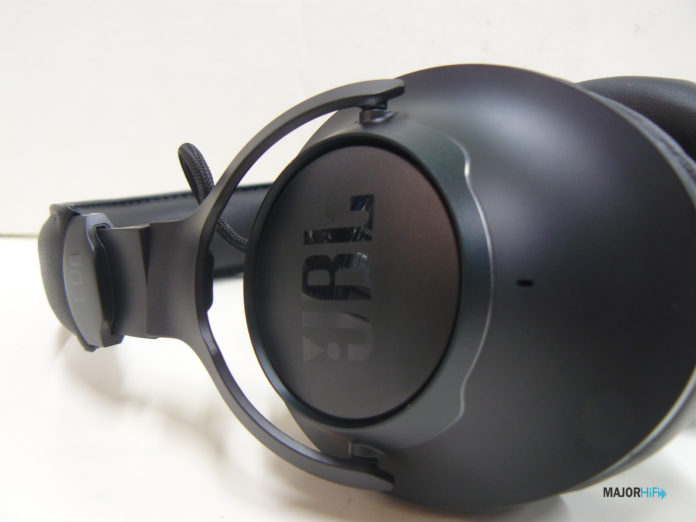It’s been a while since we took a look at good ol’ JBL. The popular consumer-friendly brand has had non-stop output for many years, delivering suitable sound systems that make them a household name. From speakers to gaming headphones, JBL has a big impact on the consumer sound system market whether or not you think they produce quality audio.
Over the past few years, a variety of manufacturers have released some critically acclaimed noise-canceling headphones. Brands like Sennheiser and Shure have elevated the level of value associated with this type of product. Now, JBL has released the Club One, a new noise-canceling headphone that aims for more prestige than their past output. This $349 headphone goes in direct competition with the Sennheiser Momentum 3, Sony XM4, and Shure Aonic 50. Can JBL hold its own against these noise-canceling behemoths?
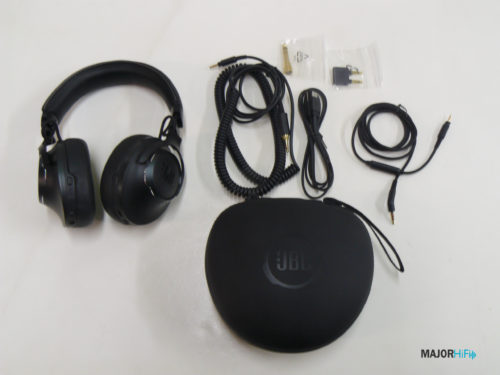
What You Get
- Aux-in cable with remote & mic
- Aux-in coiled-cable
- USB Type-C charging cable
- Hard Case & Flight adaptor
- 1 x Warranty / Warning/ QSG/ Safety Sheet / App QSR
- 6.3mm adaptor
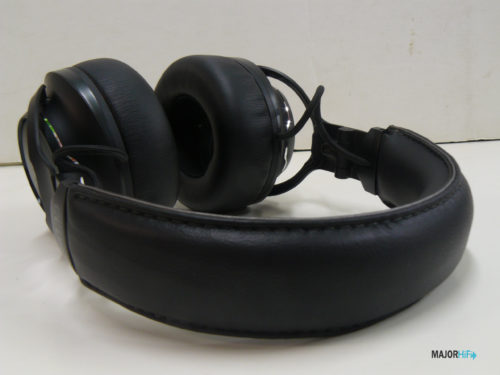
Look and Feel
When jumping up to this price range, I expect the build quality to match it. Thankfully JBL really brings their A-game here. With Club One, JBL delivers one of their most sophisticated builds. In the past, I’ve criticized JBL for using too much plastic, and have a too simple construction. There’s nothing wrong with simplicity, but it’s made JBL’s headphones appear toy-like in my opinion. Here, JBL gives the Club One a proper look, with a combination of metal and hard plastic. Even though plastic is still used here, it’s supported by metal yokes, increasing the durability and value of these headphones.
As for the fit, the earpads seem small but properly secured my ear. With the right adjustment, the Club One can offer a sufficient level of comfort for long listening sessions with minimal fatigue. The magnetic earpads that detach themselves are an odd choice, but a unique one especially for JBL. Overall the aesthetic and build quality operates at a standard level for the price and is impressive for a brand like JBL.
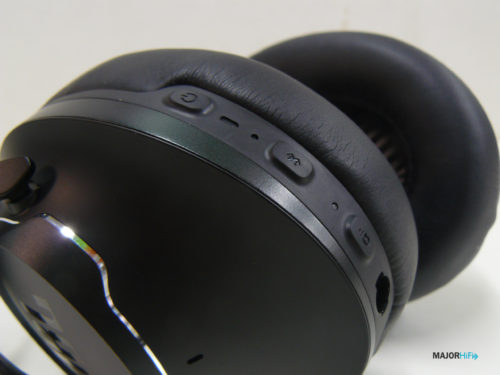
Design and Functionality
JBL implements a 40mm driver for the Club One. It’s quite sizable and produces a comfortable level of volume that definitely won’t have you blasting your volume with little room for adjustment. If you find that some wireless headphones aren’t loud enough, that shouldn’t be a problem here. The dual aux input is also a plus here, giving you 3500mW of power.
The Club One definitely doesn’t lack in features, in fact, these headphones include a laundry list of different functions aside from the advertised noise-canceling. Most of these features are accessed through JBL’s “My JBL Headphones” app, where you can not only assign which type of ambient mode gets activated by the left earcup button but select custom EQ options as well. Ambient and Talk-thru modes can be swapped for one another using the app, with ambient aware you’ll be able to pay attention to your surroundings more clearly, while Talk-thru lets you have a conversation making the music more background noise.
Other features include some more common elements like Alexa and other voice assistants. Hands-free calls are also possible on the Club One and present a standard level of clarity. Finally, I wanted to touch on this weird Stage+ option, which seemingly calibrates the headphone to a certain timbre that a DJ has adjusted for you. There weren’t many options here when I was using the app but had I spent more time with this feature I would have spoken about it more in-depth. For now, it’s just this odd extra feature that some may find interesting.
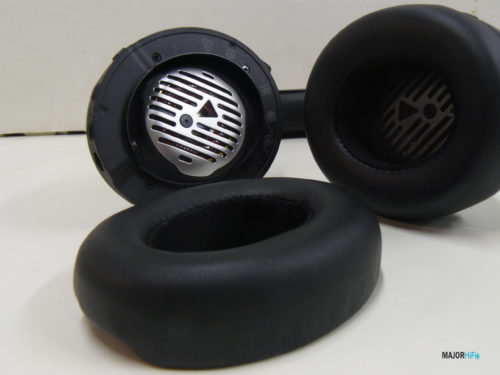
Bluetooth
I didn’t find much to complain about when it came to The Club One’s Bluetooth connection. It supports Bluetooth 5.0 and sports a multi-point connection, connecting two devices at once. It is not listed which CODECs are specifically used, but SBC and AAC should be expected.
Battery Life
One of the highlights of the Club One so far is its battery life. Playback time without ANC can range to a pretty momentous 45 hours, and almost 25 with noise-canceling on. This is very admirable for the price point, bringing you many hours of listening before having to recharge. Even then, charge time only takes about two and a half hours, and charging it for less still gives you plenty of music time.
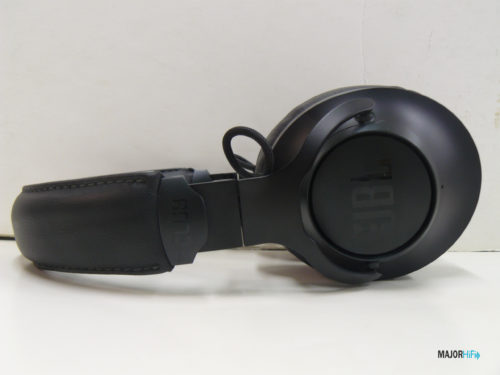
Soundstage
You know, sometimes I find we underestimate what type of sound signature JBL can deliver at times. It’s not the most detailed, or even the clearest at times, but I’ve come to appreciate how fun some of them are. So with the Club One, I obviously wasn’t expecting the most open of soundstages. Noise-canceling headphones aren’t the most capable of producing some of the greatest separation or layering, and that’s true of the Club One.
However, in terms of imaging, this headphone can feel quite grand. It all comes off as a little synthetic, but that doesn’t stop the stereo field from keeping to accurate positioning and pan movements in tracks. I’m not buying JBL for accuracy, but you can still sense that a certain level of attention was paid to keeping all of the sound elements discernible in the sound field. Still, everything appears a little too close for my taste, but I’ll take what I can get. At its best, the Club One can make tracks sound whole and larger than what you might expect, making genres that contain a lot of elements appear more dignified, and well-realized.
Low End
I always expect some good bass from JBL. Whether or not they overcrowded the mix is slightly a concern at times, but they usually know how much bass their audience likes. The Club One showcases that punchy, thick bass response you might be used to with JBL, but some of the resonance is kept tight and rather focused. This workes great for the lows and other ranges of frequency, as they can sound colorful and emphasized without clouding up a significant amount of the timbre. Hip-hop and electronic tracks will sound properly at home on the Club One, as well as give rumbly sweeteners to metal and hard rock music.
Mids
Some of the timbre can be manipulated with the parametric EQ mentioned on JBL’s headphones app, which puts the midrange in the right place for a flatter, more neutral response. There’s a surprising amount of presence here, as I expected a more recessed, maybe even a more v-shaped signature, but the Club One keeps things surprisingly natural for a headphone like this. Instruments sound properly full, and vocals stick out just enough in the mix, with an extra bit of high-mid accentuation.
Highs
Knowing how sensitive some might be to the Club One’s treble response, I’ll say that it’s pretty difficult to escape some of the headphone’s brighter qualities. I don’t think most people by JBL will be expecting this level of high-frequency color, but this was a welcome treat for this reviewer. While the response might not have the sense of air I usually prefer, I was really impressed by the Club One’s sense of crispness in some areas. It makes certain instruments and effects appear more defined than they would have in a more rolled-off treble. Even though there are some piercing elements to the tonality, I still found the frequencies to be quite digestible and even sweet at times.
Summary
Well, I truly did not expect to enjoy a JBL headphone this much, but here we are. The Club One won’t seem as high-end for wireless headphones in terms of noise cancellation, but I found the timbre here to be very satisfying. The build should also be commended, as well as the massive battery life. The companion app also brings a ton of features to the mix with switchable ambient modes and parametric EQ. It really has almost everything you would need in a Bluetooth headphone, and even the features that aren’t given the greatest showcase are still perfectly functional. At the end of the day, the sound quality here is almost like junk food for me but still possesses more than a reasonable level of enjoyment.
Pros and Cons
Pros: Build, Abundant features, Consistent timbre, Big imaging, Battery life
Cons: Average noise-canceling
The JBL Club One is available at Audio 46.
Discuss the JBL Club One on our forums here.
Compare the ranking of various headphones, earbuds and in-ear monitors using our tools.
Discuss this, and much more, over on our forum.
---MAJORHIFI may receive commissions from retail offers.


